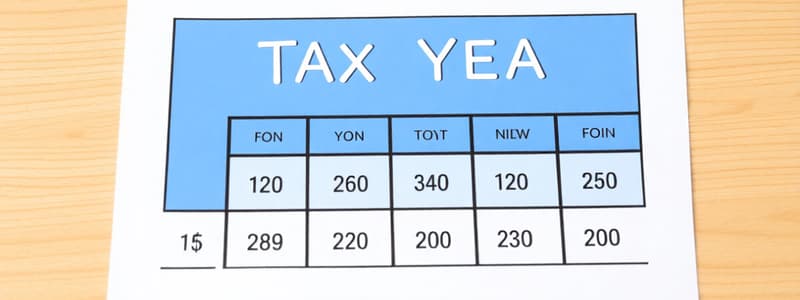Podcast
Questions and Answers
Under what circumstances would a partnership file Form 8716 instead of Form 1128 to change its tax year?
Under what circumstances would a partnership file Form 8716 instead of Form 1128 to change its tax year?
- When requesting a change to a tax year end that is not a required tax year end, and also seeking to change from the cash to the accrual method of accounting.
- When requesting a change to a required tax year end.
- When requesting a change to a tax year end that is not a required tax year end. (correct)
- When changing to a tax year end that coincides with the tax year of a newly acquired shareholder.
What type of corporation can file Form 8716 to request a change in its tax year?
What type of corporation can file Form 8716 to request a change in its tax year?
- Only personal service corporations (PSCs).
- Only C corporations.
- Only S corporations.
- Partnerships, S corporations, and personal service corporations (PSCs). (correct)
A partnership currently operates on a calendar year. A corporation acquires over 50% ownership and has a fiscal year ending June 30. Can the partnership change to a June 30 year end without filing Form 8716?
A partnership currently operates on a calendar year. A corporation acquires over 50% ownership and has a fiscal year ending June 30. Can the partnership change to a June 30 year end without filing Form 8716?
- No, because June 30 is not a required year end for the partnership.
- Yes, as long as the partnership files Form 1128 and is denied permission by the IRS.
- No, because June 30 is a required year end for the partnership. (correct)
- Yes, as long as the partnership files Form 1128.
When can a short tax year occur?
When can a short tax year occur?
What is the name of the election that allows a partnership, S corporation, or PSC to change its tax year to a year end that is not a required year end?
What is the name of the election that allows a partnership, S corporation, or PSC to change its tax year to a year end that is not a required year end?
A taxpayer who does not keep books, has no annual accounting period, or has an annual accounting period other than a calendar year that does not qualify as fiscal year is required to adopt which tax year?
A taxpayer who does not keep books, has no annual accounting period, or has an annual accounting period other than a calendar year that does not qualify as fiscal year is required to adopt which tax year?
Which of the following is NOT a requirement for a fiscal year to be recognized?
Which of the following is NOT a requirement for a fiscal year to be recognized?
A taxpayer who changes their annual accounting period from a fiscal year to a calendar year is required to file a return for:
A taxpayer who changes their annual accounting period from a fiscal year to a calendar year is required to file a return for:
What is the primary factor the IRS considers when granting permission to change tax years?
What is the primary factor the IRS considers when granting permission to change tax years?
Which government form is typically used to request a change in tax years?
Which government form is typically used to request a change in tax years?
A short tax year can occur if a taxpayer:
A short tax year can occur if a taxpayer:
Which of the following is NOT a valid ending date for a 52- or 53-week tax year?
Which of the following is NOT a valid ending date for a 52- or 53-week tax year?
What is the key difference between a calendar year and a fiscal year?
What is the key difference between a calendar year and a fiscal year?
Flashcards
Form 8716
Form 8716
Filed with the IRS to change a tax year for certain entities.
Sec. 444 election
Sec. 444 election
A means for certain entities to elect a tax year other than the required one.
Short tax year
Short tax year
Occurs when a business changes accounting periods unexpectedly.
Accrual method
Accrual method
Signup and view all the flashcards
Required tax year
Required tax year
Signup and view all the flashcards
Tax Year
Tax Year
Signup and view all the flashcards
Calendar Year
Calendar Year
Signup and view all the flashcards
Fiscal Year
Fiscal Year
Signup and view all the flashcards
Annualization
Annualization
Signup and view all the flashcards
Form 1128
Form 1128
Signup and view all the flashcards
Substantial Business Purpose
Substantial Business Purpose
Signup and view all the flashcards
52- or 53-week Tax Year
52- or 53-week Tax Year
Signup and view all the flashcards
Study Notes
Tax Years
- Taxpayers adopt a tax year when their first income tax return is filed.
- A tax year is the annual accounting period used to record income (calendar or fiscal year), or the return period if less than 12 months.
- Calendar year: 12 months ending December 31.
- Fiscal year: 12 months ending on the last day of any month except December, or a 52- or 53-week period.
- A 52- or 53-week fiscal year is valid if it always ends on the same day of the week, either the last day of a calendar month or the closest day to the end of the month.
- Short tax year: a period less than 12 months. Can occur if a business exists only part of the year, or changes its accounting period (e.g., from fiscal to calendar).
Short Tax Year Calculation
- To calculate taxes for a short tax year, annualize the income, calculate taxes on the annualized income, then determine the short tax year's portion of the tax.
Changing Tax Years
- Form 1128 is used to request a change in tax year with the IRS (typically for a substantial business purpose).
- It must be filed by the federal income tax return due date.
- A substantial business purpose is needed, not just to get a favorable tax status.
- Form 8716 is used to request a change in tax year other than a required tax year (Sec. 444 election).
- It can be used without needing permission first.
- Partnerships, S corporations, and personal service corporations use this form.
Example
- A partnership with a calendar year changes to a June 30 year-end after a corporation gains majority ownership and also has a June 30 tax year. Form 8716 would be used.
Important Considerations
- A change in accounting method (e.g., from cash to accrual) does not cause a short tax year.
- Changes in a 52- or 53-week tax year could lead to a short tax year.
Studying That Suits You
Use AI to generate personalized quizzes and flashcards to suit your learning preferences.





